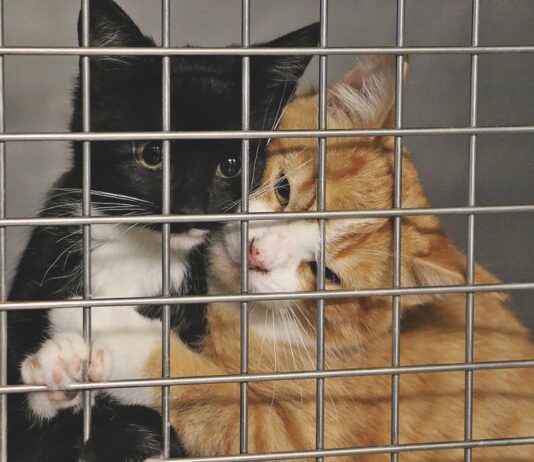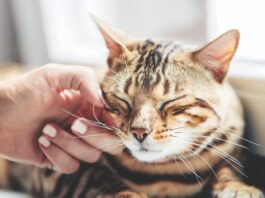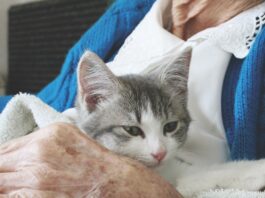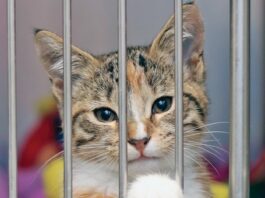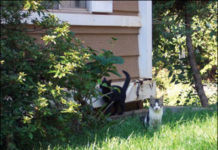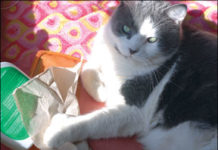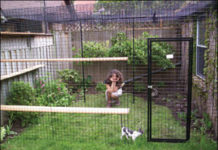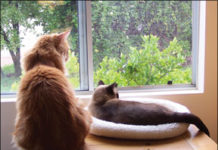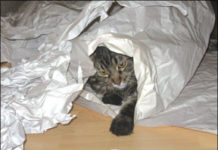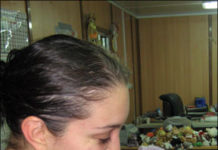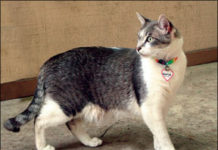Hark, Who Goes There?
Quite often, I am told tales of apparently mild-mannered cats that seem to tolerate all of lifes challenges save one: the Trespasser. When face to face with a Cat Errant, Mr. Mellow just cannot cope. We are all cat lovers and certainly wish no harm to our neighbors cats. But naturally, we want to look out for our family. When a resident cat spies a potential intruder, several responses are possible. If you are lucky, your cat might believe that the more, the merrier. He may chirp, he may posture in a beckoning manner, or he may continue to nap calmly, with no apparent interest in the antics of his comrade through the glass. If you are less lucky, you may find that your cat does not trust that the glass is sufficient to keep an offending cat at bay. He may post "Private Property" signs of his own. You may come home to discover that your windows and doors have been marked with urine. If you manage to get through the winter months unscathed, beware the ides of April. For when the windows are opened for a little fresh air, the urgency to reset the barriers will return. The most concerning cat of all is the cat that experiences profound fear upon viewing an unfamiliar cat. The frightened cat may respond by redirecting aggression toward a member of your household. Although other cats are most frequently targeted, other pets and people may find themselves victims of serious attacks. The impact on a relationship can be devastating. Fortunately, you can intervene. You will need to work with both sides of the equation.
Cleaning Naturally
The cleanser you scrubbed your counter with makes your kitchen smell fresh and clean. It also makes it into a hazardous waste site for your cat. Common household cleaners carry labels warning of their dangers, and so most people use gloves or wash their hands after using them. But every time your cat walks across a newly cleaned counter or floor and then grooms itself, it ingests the cleaning product. Even if you rinse and dry the area, some residue can remain. Cleansers such as Lysol contain phenols and alcohol, both of which are toxic to cats and can cause digestive upset and irritations in the mouth. Bleach, a popular cleaning product, will cause skin irritation; when combined with ammonia, it forms poisonous chlorine gas. Any product containing pine oils, such as Pine Sol, can cause liver damage. Some vets say theyve never seen an example of cleanser-caused toxicity in cats. But we know from human studies that the effects of environmental toxins are not always obvious. Rather than risk skin irritation or liver failure, why not use natural cleansers that are safe for pets and humans? And theres no need to spend a fortune on fancy "green" products, either. Your kitchen cupboard probably has all the cleaning power youll need to keep your home sparkling.
Create An Outdoor Enclosure For Your Cats
Some cats seem to pine for sunshine and fresh air, despite all the arguments in favor of keeping cats indoors. Cat enclosures are the perfect way to give cats access to the outdoors without compromising their safety. In an enclosure, your cat wont be able to wander away and get in trouble with cars or the neighbors. An enclosure with a roof is far safer than a fenced-in yard, because although fences can be adapted to keep cats in, they wont necessarily keep other animals out. But in an enclosure your cat will be able to enjoy the sunshine and youll be able to relax, knowing your cat is safe inside. Everything from small, pre-fabricated enclosures perfect for limited yard space to giant, custom-built models that enclose entire yards can be bought on-line. Or use your own imagination to create an outdoor play space for your cat, attached to your house or free-standing. Dont neglect vertical space in your design; cats love to go up as much as they love to explore the ground. When building your own enclosure, use only sturdy materials that your cat cant destroy and that wont degrade too quickly from exposure to weather. Plan your design carefully; as the saying goes, measure twice and cut once. Dont forget to include an opening big enough for you in the design - youll need access, too. Youll probably want to add a lock to this human-sized door, to discourage unwanted entry.
Foreclosures: Cats in Peril
With the numbers of foreclosures rising on a daily basis in some areas of the country, realtors and foreclosed-property inspectors relate that they are making an alarming discovery: Pets have been found locked in the home without food or water, abandoned in the streets or let loose in yards. It is obvious that foreclosures are not just affecting people; they are also affecting the pets of evicted families. With an estimated 34 percent of all home owners owning one or more cats (2007 AVMA US Pet Ownership and Demographics Sourcebook), and more than 1.6 million foreclosures recorded in the month of December 2008 alone, the potential for displaced cats is enormous. Just how many cats are being affected by foreclosures is more elusive than estimating the impact on pet dogs, notes Janet Scarlett DVM, MPH, PhD, professor of Epidemiology and director of Maddie's Shelter Medicine Program at Cornell Universitys College of Veterinary Medicine. A dog that is left behind is usually spotted and found. "A cat that has been put in the yard isnt going to be found by a realtor. For that reason, its much harder to measure the problem accurately," she notes. Recent intake numbers (the number of surrendered, stray or abandoned pets that are taken into a shelter) from areas hardest hit economically support the theory that many pets, including cats, are suffering from the first wave of foreclosures. For example, the Los Angeles Animal Services experienced a 20 percent increase in intake numbers in 2008. One Atlanta, GA shelter reported a 71 percent increase in intake numbers last year; and, a shelter in Fulton County, GA tallied a 250 percent intake increase in 2008 during an eight month period (March through December).
Help for the Choking Cat
Cats are known to be fastidiously discriminating in their eating behavior. Compared to dogs, they are extremely cautious about what they take into their mouths. Owing to their finicky habits, a cat is unlikely to ingest anything that could cause it to choke. But accidents do happen. A cats environment is full of countless little objects, from sticks, stones and rodent bones - to thimbles, buttons, rubber bands and strands of yarn. If a cat inadvertently takes such a foreign object into its mouth, is not immediately able to disgorge it and attempts to swallow it, the animals upper respiratory apparatus can become blocked and its oxygen supply can become seriously diminished or totally impeded. Oxygen deprivation can cause death within a matter of minutes. Therefore, any signs of choking must be viewed as an emergency situation requiring immediate attention. However, says Gretchen Schoeffler, DVM, chief of emergency and critical care services at the Cornell University Hospital for Animals, veterinarians rarely treat cases of feline choking. This is because such traumatic events tend to be either (1) self-limiting; (2) relieved thanks to prompt action by an affected animals owner; or (3) fatal before veterinary help can be obtained.
Ten Ways to Go Green
It should come as no surprise that Mother Nature is on the verge of taking a permanent sick day. After all, harmful climate changes due to greenhouse gases, air and water pollution, and the destruction of natural habitats are putting our planet and its inhabitants - both two- and four-legged - in peril. Hopefully, many of us have begun to make some changes in our daily lives to help reverse the damage done to, well, everything. But what role can our cats play in being good stewards of our beleaguered planet? There are many practical ways to reduce your felines carbon pawprint, which include switching to a corn or wheat-based cat litter and recycling cat food containers instead of throwing them in the trash. Get a jump start on Earth Day (April 22) by incorporating the following tips into your daily routine. Start out slowly if you wish by trying one or two new tips each week. Encourage your friends, family members and co-workers to join in your quest for a sustainable future. Youll find that its not only fun and easy to "go green," but youll see that you can make a positive and lasting impact on our world, which will please Mother Nature.
Short Takes
A study in the Journal of the American Veterinary Medical Association (Vol. 234, No. 2) found that some dietary supplements dont dissolve fast enough to be absorbed by cats and dogs. The report was titled "Composition, disintegrative properties, and labeling compliance of commercially available taurine and carnitine dietary products" and said that two out of three (labeling and composition) were adequate. Researchers concluded: "Taurine and carnitine products evaluated in this study closely adhered to manufacturer claims and labeling guidelines. However, disintegration testing suggested high variability in some products, possibly limiting uptake and use by animals that receive them."
Pet Care on a Budget
With the economy stumbling, the prospect of hundreds of dollars a year in cat care may seem daunting. But dont worry: There are plenty of ways to defray the cost of owning a cat without compromising your pets well-being. In fact, some of the most effective strategies will actually benefit your cat. As Jodi Korich, DVM, director of Partners in Animal Health at Cornell Universitys College of Veterinary Medicine explains, "One of the best ways to save money on your pets health is to pay attention to early disease detection and preventive health care." Just like oil changes and preventive maintenance result in fewer repair bills for your car, she says, regular check-ups and early intervention will save you money in the long run. Dental hygiene tops Dr. Korichs list of money-saving health care. Dental disease is the most common malady cats suffer, afflicting fifty percent of all cats. Learning to brush your cats teeth at home can make a tremendous difference in your cats oral health. While its not easy to become an expert at cat-brushing, it costs little and can save a lot. Early intervention is equally important. Because you know your cat better than anyone, youre in the best position to spot subtle changes that might indicate a medical problem. Dont ignore something small in the hopes that it will go away because the cost of a cure gets larger the bigger the problem gets. Make it a habit to examine your cat weekly for things like missing hair, skin bumps, tearing eyes or excessive drooling. Keep an eye out for changes in your cats routine, such as a change in appetite or bowel habits.
No Kitty Left Behind: Operation Baghdad Pups
Operation Baghdad Pups, an SPCA International initiative, helps Americans serving in Iraq bring home the animals theyve befriended while on duty. Though at first glance, it might appear that Operation Baghdad Pups is limited to canines, roughly ten percent of the pets in the program are cats. The first cat to come "home" to the states through the program was a small, calico kitten that had been hiding in a trucks engine compartment. Bruce, an American contractor working in Northern Iraq, estimates the kitten was riding in the engine for more than 30 km before she jumped out from under the hood. Alarmed by the kittens serious injuries to one of her front legs, Bruce and a security medic liaison officer treated her "in the field." When she didnt improve after a few days, Bruce took the kitten to the site emergency medical doctor, who gave her further medical treatment. Bruce relates that in an environment in which he had little social contact and spent every waking hour installing "important basic infrastructure" to the local people in Northern Iraq, the little kitten "Hope" filled a void in his life. When the kitten was well enough to venture outside, she quickly befriended the rest of the camp and became a well-loved, affectionate mascot. The day came, of course, when it was time for Bruce to head home; however, he couldnt bear the thought of leaving "Hope" behind. She lacked all survival skills of a feral cat, he explains, and with the emotional attachment he had made during the six months the two had been together, "It would be like me abandoning my own child."
Help for the Matted Cat
While it may seem unlikely to you (given the reputation cats have for personal hygiene and grooming habits), a trip to the groomers can sometimes become necessary for a badly matted cat. There are several factors which can contribute to the matting of a cats haircoat, two ways to deal with it - and one simple way to avoid it in the future. Jana West, owner and operator of Shampooch, located in Savona, NY, has been grooming cats and dogs for eight years. West relates that the most common places for a cat to develop mats are on the back - near the tail, under the belly, along the hind legs and under the tail. She explains that there are three types of cats that [IMGCAP(1)]are more prone to developing mats in their haircoat: "The majority of the cats that have a problem are older cats, bigger cats or cats allowed to spend time outdoors." As cats age, grooming may become less important to them. In addition, cats with a weight issue may have more difficulty reaching certain areas of their bodies. And when it comes to outdoor cats, West adds, "Ideally, all cats would be kept inside and wouldnt come in contact with burrs and branches, but thats not always realistic."
Cat Collars for Safety
As a human companion concerned about your feline, your question should not be if your cat needs a collar - but what type of collar your cat needs. All cats need a collar and an ID tag. That may come as a surprise to you if you keep your cat indoors. But many lost cats were indoor cats at the time they went missing. "Almost half the people who have lost a cat never expected their indoor-only cat to get outside," says Brenda Griffin, DVM, MS, with the Department of Population Medicine and Diagnostic Sciences of Cornell University's College of Veterinary Medicine. Indoor cats get frightened and bolt out of the house, a guest leaves the door open accidentally, your family must vacate the house in an emergency or natural disaster. Anything can happen. An indoor cat that finds itself outside is particularly vulnerable to getting lost and becoming a stray because its not used to being outdoors and finding its way home. Whatever scared your cat in the first place may cause your cat to stay in hiding, not come home or prevent you from finding it. "We strongly encourage people to collar their cats - even if theyre strictly indoor cats," says Brenda Griffin, the veterinarian in charge of initiatives to promote pet ID for both cats and dogs at Cornell University. "We consider an ID collar an essential component of a wellness program for all pet cats (wellness equals preventive medicine)." Outdoor cats are as easily lost. People may think a cat doesnt belong to anyone and may take the cat away from the area. A collar immediately signifies that a cat has a home. If the unthinkable happens and your cat - indoor or outdoor - gets lost, the chances of your cat being found and returned to you are infinitely higher if your cat is wearing some form of ID.
Disaster Help: In the Wake of Hurricane Ike
As a result of Hurricane Ike, the Houston SPCA rescued more than 1800 animals; fed/watered 500 animals that were left in their homes by evacuating families; placed more than 450 pets in temporary foster homes, and celebrated nearly 400 miraculous reunions. Prior to Hurricane Ike making landfall, the Houston SPCA worked in concert with other area shelters: Dogs and cats were relocated from the Houston SPCA to shelters in outlying areas, so that dogs and cats from coastal shelters in danger of destruction could be moved to safety in Houston. In addition, the Houston SPCA coordinated evacuation efforts for owners in need of crates, carriers, muzzles, leashes and other travel items necessary to safely evacuate their beloved pets with them to shelters, hotels and other temporary living arrangements. The question remains, of course, why were so many pets left behind when owners had more than a week to prepare a safe evacuation? Under the Pets Evacuation and Transportation Standards (PETS) Act of 2006, state and local emergency preparedness authorities were required to accommodate households with pets or service animals in their evacuation plans. "The common reasons we heard [for leaving pets behind] were, We didnt think wed be gone so long, We left food on the table, or theyd say, We thought theyd be fine," relates Meera Nandlal, public relations manager for the Houston SPCA in Houston, Texas.

